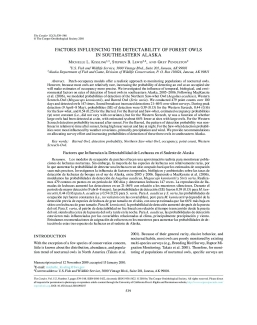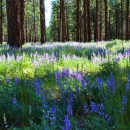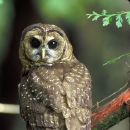
Patch-occupancy models offer a realistic approach to monitoring populations of nocturnal owls. However, because most owls are relatively rare, increasing the probability of detecting an owl at an occupied site will make estimates of occupancy more precise. We investigated the influence of temporal, biological, and environmental factors on rates of detection of forest owls in southeastern Alaska, 2005–2006. Following MacKenzie et al. (2006), we modeled probabilities of detection of the Northern Saw-whet Owl (Aegolius acadicus), Western Screech-Owl (Megascops kennicottii), and Barred Owl (Strix varia). We conducted 479 point counts over 100 days and detected owls 147 times. Sound broadcast increased detections 21–86% over silent surveys. During peak detection (9 April–8 May), probabilities (SE) of detection were 0.39 (0.13) for the Western Screech, 0.44 (0.16) for the Saw-whet, and 0.54 (0.25) for the Barred. For the Barred and Saw-whet, estimated occupancy probabilities (ψ) were constant (i.e., did not vary with covariates), but for the Western Screech, ψ was a function of whether large owls had been detected at a site, with estimated ψ about 66% lower at sites with large owls. For the Western Screech detection probability increased after sunset. For the Barred, the pattern of detection probability was nonlinear in relation to time after sunset, being high near sunset and late at night. For the Saw-whet detection probabilities were most influenced by weather covariates, primarily precipitation and wind. We provide recommendations on allocating survey effort and increasing probabilities of detection of these three owls in southeastern Alaska.
| Attachment | Size |
|---|---|
| Kissling.etal2010.pdf294.36 KB | 294.36 KB |


